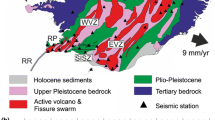Abstract
A method for the determination of consistent local magnitude M L values (Richter scale, or M WA) for earthquakes with epicentral distances ranging from 10 km through 1000 km is demonstrated. The raw data consists of nearly 1300 amplitude readings from a network of six digital seismographs in Baden–Württemberg (Southwestern Germany) during 26 months starting in 1995, later extended by another 1000 amplitude readings until 1999. Relying on most of the basics introduced by C.F. Richter a three-parameter attenuation curve (distance correction, magnitude-distance relation) for Baden–Württemberg and adjacent areas is presented. Station corrections are evaluated and the attenuation curve is calibrated with respect to other agencies for distances greater than 650 km. Reasonable parametrisations are discussed and meaningful error bars are attributed. Finally, a seventh station is incorporated by means of its station correction alone, without needing to update the attenuation curve.
Similar content being viewed by others
References
Bakun WH, Joyner WB (1984) The ML scale in central California. Bull Seis Soc Am 74:1827–1843
Ben-Zion Y (2001) On quantification of the earthquake source. SRL 72:151–152
Bormann P, Bergman E (eds) (2002) The new manual of observatory practice. GeoForschungsZentrum Potsdam, Germany
Bragato PL, Tento A (2005) Local magnitudes in northeastern Italy. Bull Seis Soc Am 95.2:579–591
Brüstle W, Stange S (2002) Earthquakes in Baden-Württemberg, 2000; Bulletin of the Earthquake Survey of the State Bureau for Geology, Natural Resources and Mining Baden-Württemberg, Freiburg
Douglas J, Suhadolc P, Costa G (2004) On the incorporation of the effect of crustal structure into empirical strong ground motion estimation. Bull Earthquake Engineering 2(1):75–99
Efron B, Gong G (1983) A leisurely look at the bootstrap, the jackknife and cross–validation. The American Statistician 37:36–48
Ferdinand RW (1998) Average attenuation of 0.7–5.0Hz Lg waves and magnitude scale determination for the region bounding the western branch of the East African Rift. Geophys J Int 134:818–830
Gasperini P (2002) Local magnitude revaluation for recent Italian earthquakes (1981–1986). J Seis 6.(4):503–524
Henger M, Leydecker G (eds) (2000) Erdbeben in Deutschland 1994, Bundesanstalt für Geowissenschaften und Rohstoffe, Hannover, p 47
Hough S (2000) On the scientific value of “Unscientific” data. SRL 71:483–485
Hutton LK, Boore DM (1987) The ML scale in southern California. Bull Seis Soc Am 77:2074–2094
Jennings PC, Kanamori H (1983) Effect of distance on local magnitudes found from strong–motion records. Bull Seis Soc Am 73:265–280
Kanamori H (1977) The energy release in great earthquakes. J Geophys Res 82:2981–2987
Kanamori H (1983) Magnitude scale and quantification of earthquakes. Tectonophysics 93:185–199
Kim W-Y (1998) The ML scale in Eastern North America. Bull Seis Soc Am 88:935–951
Kvamme LB, Hansen RA, Bungum H (1995) Seismic–source and wave–propagation effects of Lg waves in Scandinavia. Geophys J Int 120:525–536
Langston CA, Brazier R, Nyblade AA, Owens TJ (1998) Local magnitude and seismicity rate for Tanzania, East Africa. Bull Seis Soc Am 88:712–721
Leydecker G (1986) Erdbebenkatalog für die Bundesrepublik Deutschland mit Randgebieten für die Jahre 1000–1981, in: Geologisches Jahrbuch, E36, 3-83, Bundesanstalt für Geowissenschaften und Rohstoffe, Hannover.
Leydecker G, Aichele H (1998) Seismogeographical regionalisation of Germany: the prime example for third–level regionalisation. in: Geologisches Jahrbuch, E55, 85–98, Bundesanstalt für Geowissenschaften und Rohstoffe,Hannover.
Nicolas M, Massinon B, Mechler P, Bouchon M (1982) Attenuation of regional phases in western Europe. Bull Seis Soc Am 72:2089–2106
Press WH, Flannery BP, Teukolsky SA, Vetterling WT (1986) Numerical Recipes. Cambridge University Press, New York, p 993
Richter CF (1935) An instrumental earthquake magnitude scale. Bull Seis Soc Am 25:1–31
Richter CF (1958) Elementary Seismology. W. H. Freeman and Co., San Francisco, pp 578
Schick R, Wielandt E (1994) Zur Geschichte der instrumentellen Erdbebenbeobachtung und Erdbebenforschung in Württemberg und Hohenzollern. Jh Ges Naturkde Württemberg 149:75–98
Shearer PM (1997) Improving local earthquake locations using the L1 norm and waveform cross correlation: application to the Whittier Narrows, California, aftershock sequence. J Geoph Res 102:8269–8283
Stange S, Friederich W (1993) Surface wave dispersion and upper mantle structure beneath Southern Germany from joint inversion of network recorded teleseismic events. Geoph Res Lett 20:2375–2378
Uhrhammer RA, Loper SJ, Romanowicz B (1996) Determination of local magnitude using BDSN broadband records. Bull Seis Soc Am 86:1314–1330
Wessel P, Smith WHF (1991) Free software helps map and display data. EOS Trans Amer Geophys U 72(441):445–446
Author information
Authors and Affiliations
Corresponding author
Rights and permissions
About this article
Cite this article
Stange, S. M L Determination for Local and Regional Events Using a Sparse Network in Southwestern Germany. J Seismol 10, 247–257 (2006). https://doi.org/10.1007/s10950-006-9010-6
Received:
Accepted:
Published:
Issue Date:
DOI: https://doi.org/10.1007/s10950-006-9010-6




